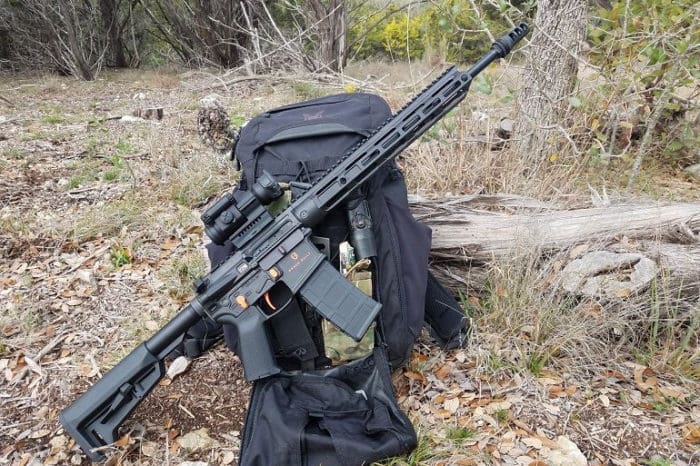The AR-15 platform rifle is the most popular rifle in the United States. Yet somehow, the meaning of “AR” (as in the AR-15 or AR-10 rifles) continues to be the subject of much debate. We’d have thought the matter was settled long ago. Some still claim AR means “assault rifle” or even “automatic rifle.” Some of that is due to ignorance, but lots of people and media organizations have an interest in continuing to spread misinformation about the rifle’s origin and what ‘AR’ really means.
So in the interest of clarity and accuracy we’ll repeat this one more time; ‘AR’ stands for “ArmaLite Rifle.” ArmaLite is the company that developed the rifle back in the 1950s, along with the brilliant firearms design Eugene Stoner.
Wait, some of you say. Weren’t they made by Colt? We’ll get to that in a minute. But first, From The Pages Of Firearm History . . .
ArmaLite — initially styled “Armalite” — was a small arms concern started by George Sullivan, a patent lawyer who worked for Lockheed. The Fairchild aircraft company realized the potential for small arms manufacturing (with an eye on selling them to the military) and bankrolled the new operation.
They hired some personnel, including Eugene Stoner, and set to work creating new rifle designs.
Their first designs were the AR-5 and AR-7 takedown rifles, which found adoption as survival rifles for military pilots in the early 1950s. Since the US military was looking for a new battle rifle to replace the aging M1 Garand, Stoner et al. set about making a better gun.
The first design was not, in fact, the AR-15. ArmaLite’s nomenclature is ArmaLite and then the model number, with AR-1 being their first design. The AR-10 came first, with work commencing in 1954/1955.
Stoner and his small team (the company had fewer than ten employees at the time) created some innovative features. The stock was polymer, reducing overall weight. Trigger pull was rather light for rifles of the day. The firing system was changed from a traditional gas piston system to a direct impingement system to simplify the action, along with a rotating bolt.
Without getting overly bogged down in the details (the comments section can fill in the blanks if they wish; this is the elevator version here) a standard gas-operated semi-automatic rifle or shotgun works by using exhaust gases to drive a piston which in turn cycles the action. Direct impingement pipes exhaust gases directly into the receiver, cycling the bolt carrier.
The upside is that it makes the rifle simpler, which allows it to be lighter. That was part of what the Army said it wanted in a new battle rifle. The downside is that exhaust gases and particulate matter are piped directly into the action, making it dirtier and accelerating wear on parts.
Anyhow, the first version — the AR-10 — was chambered for the 7.62x51mm cum .308 Winchester round and submitted for Army trials. That design included features you’d recognize, including the charging handle and carry handle, as well as the hinged upper and lower receiver.
However, the Army thought the design was a bit undercooked and selected the then-T44 rifle, re-designated the M14, as its new rifle instead. But since the M14 was known to be near uncontrollable under full-auto operation and the M1 carbine was considered weak sauce, the US army asked ArmaLite to cook up a version in .223 Remington (later changed to 5.56mm NATO) that would be easier to lay down suppressive fire with.
The rifle had to weight 6 lbs. unloaded, had to be effective out to 500 yards, and carry a 20-round (at least) magazine. Stoner and ArmaLite said “No problem!” and came up with the AR-15, which underwent successful testing in in 1957 and 1958. However, the US Army (in fact, Gen. Maxwell Taylor) nixed adopting it in favor of sticking with the M14.
At that point, stymied by the government changing its mind about whether they wanted the thing or not (and knowing they wouldn’t have be able to cope with demand anyway) ArmaLite sold the design to Colt, who re-branded it the Colt ArmaLite AR-15, to honor the company that developed it. When it became obvious that the M14 wasn’t cutting the mustard, the military finally changed its tune.
The military version of the rifle, eventually designated the M16, was select-fire capable and also added a forward assist. Adoption began in 1963. A civilian version (semi-automatic only) was introduced by Colt (the first was dubbed the AR-15 Sporter) in 1964 during the Vietnam War. It was also sold to law enforcement as well as civilian sport shooters. The M16 underwent a number of revisions and eventually became the modern M4 carbine that’s used today.
ArmaLite, the company, continued developing rifle designs, but fell into relative obscurity and wound up pushing up the daisies by the 70s. The brand was revived by the late 1990s, and now sells rifles based on Stoner’s designs.
Today, the AR-15 is the most popular style of modern sporting rifles among American gun owners. (No, they’re not “assault weapons”…that’s another story entirely). Everyone and their brother now makes them. Colt’s patents lapsed in the 1980s, so any gun company can get into the business and they have.
Long story short, the “AR” in AR-15 never, ever meant “assault rifle” or anything remotely close to that. It always stood for ArmaLite. Pay no attention to what the gun control industry or the media may try to tell you. Just so now you know.
